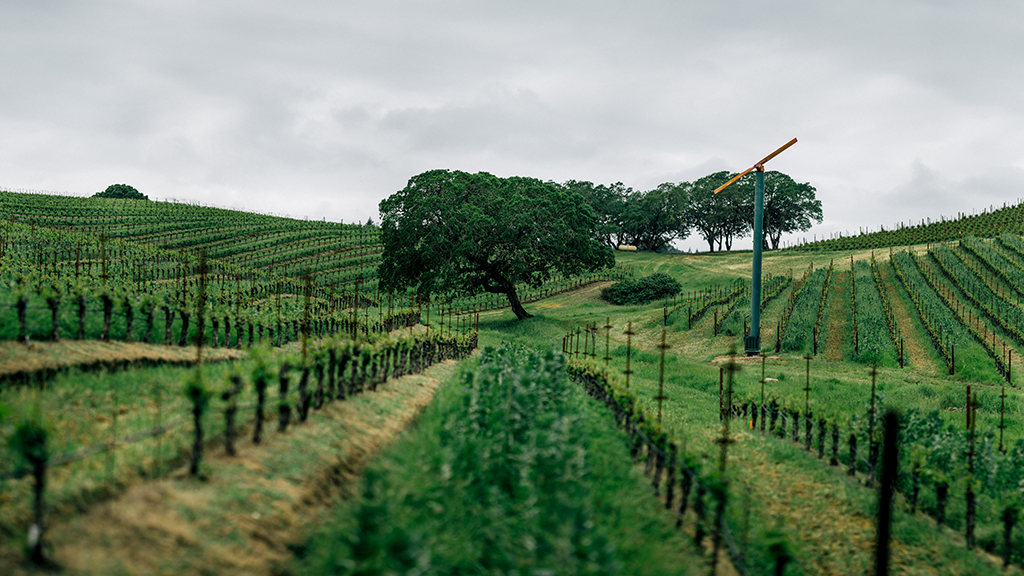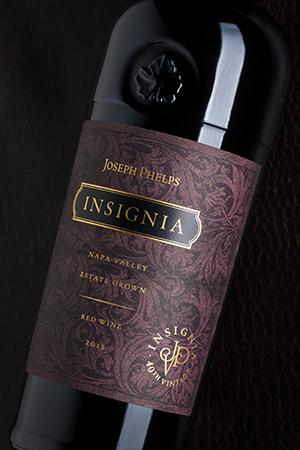Joseph Phelps Vineyards released its first wines—Insignia and a Syrah—in 1974. The winery had been completed just in time for harvest. Walter Schug was the winemaker, a position he would hold for a decade.
While Phelps’ 1973 was the first varietally-labeled Syrah in U.S. history, it is the other wine, Insignia, for which Joseph Phelps Vineyards quickly became best known. Today, Phelps Insignia is one of the most iconic wines of Napa Valley. It’s track record of high scores and collectability has been built not just on lip-smacking drinkability, but also complexity and consistency. And, though it is a wine that drinks well young, it can age magnificently.
Creating that proprietary name—a unique concept at the time—allowed more flexibility in blending than a varietal moniker would have and also avoided the standard fallbacks of the time, “Claret” or “Bordeaux Red.” And, over the years, there was an evolution in varietal makeup, though the wine has always been chiefly Cabernet Sauvignon.
 The first vintage of Insignia was essentially pure Cabernet Sauvignon from the Steltzner Vineyard. By 1976, Eisele Vineyard was contributing 94% of the fruit and some Merlot had been added to the mix. As Phelps’ estate vineyards, planted in 1973, came on line, that fruit was integrated into the blend and more sources of grower fruit were used in order to enhance complexity and maximize quality in any given vintage. (For the same reason, Cabernet Franc, Malbec and Petit Verdot are often included too.)
The first vintage of Insignia was essentially pure Cabernet Sauvignon from the Steltzner Vineyard. By 1976, Eisele Vineyard was contributing 94% of the fruit and some Merlot had been added to the mix. As Phelps’ estate vineyards, planted in 1973, came on line, that fruit was integrated into the blend and more sources of grower fruit were used in order to enhance complexity and maximize quality in any given vintage. (For the same reason, Cabernet Franc, Malbec and Petit Verdot are often included too.)
The 1985 Phelps Insignia was 25% estate, with the rest coming not just from Eisele, but also Markham, Tench, To Kalon, Las Rocas and more. In the years that followed, Phelps continued to add more acreage of their own and increase the ratio of estate fruit in Insignia. The 1998 vintage was 80% estate. 2004 was the first vintage of Insignia to be 100% estate and every subsequent release has fit that mold.
Not long ago, I participated in a remarkable vertical tasting of Phelps Insignia, alongside Will Phelps, current winemaker Ashley Hepworth, and others. We enjoyed 13 vintages of the wine, from 1976 through the current release, 2013. A couple of the wines from magnum, most from 750. Every wine was excellent, many truly remarkable.
Thirteen Vintages
 1976 Joseph Phelps Insignia
1976 Joseph Phelps Insignia
An elegant wine for sipping in the library of your manor house. Medium+ body with fine-grained tannins. Aromas of dry cedar, spice, dry tobacco, black currant and rose petal. Licorice, tobacco, spice, dried currant and blackberry, dark chocolate and iron on the palate. At peak.
1985 Joseph Phelps Insignia
Medium+ body with matching tannins (fine-grained and chalky). Earth, drying eucalyptus leaves, spice, ripe red fruit and cedar on the nose. Long flavors of rare beef, iron, chewy ripe red cherry, dark berries, moist cedar and tea. At peak.
1998 Joseph Phelps Insignia
Many critics panned the vintage overall, but you wouldn’t know it by this wine which still has great concentration and plenty of fruit. Dusty oak, dark chocolate, dry leaves and graphite aromatics, flavors of cassis, dark chocolate, spice and drying leaves. Very fine, soft and powdery tannins. At or near peak.
2004 Joseph Phelps Insignia
Rich, intense and still an opaque ruby in the glass. Full-bodied with soft, mouth-coating tannins. Black currant, black berry and black cherry, dark chocolate mousse and spice on the nose and palate. In an excellent drinking window but has room to evolve.
2005 Joseph Phelps Insignia
Seamless, fairly youthful and very concentrated. Medium+ body with very fine, soft, chalky tannins. The nose shows rich, dark fruit, graphite, raisin and dark chocolate. Flavors include dark fruit, red cherry, medium-dark chocolate and a hint of dry leaves.
2006 Jospeh Phelps Insignia
Largely about texture right now as the flavors are still tightly wound. Ripe dark fruit, chocolate and dry leaves with loads of very fine, soft and chalky tannin.
2007 Joseph Phelps Insignia
Will age for… ages. Full-bodied with firm structure. For now, the black currant jam is still peering out from behind chocolate, wood and dry, leafy spice.
2008 Joseph Phelps Insignia
Medium+ body with plenty of texture. Earthy dark fruit, drying leaves, spice, bergamot and a hint of charcoal. Drink it with a ribeye now or cellar until 2019+.
2009 Joseph Phelps Insignia
Full-bodied and structured. Dark fruit and licorice on the nose, dark chocolate, black fruit jam, oak and espresso on the palate. Hold until 2020+.
2010 Joseph Phelps Insignia
A superb wine. Inky purple in the glass with notes of dry leaves, spice, chocolate mousse, violets and dark berries. The palate is sumptuous: full-body, and loaded with fine, chalky tannins but also fresh. Flavors of blackberry jam, moist charcoal and chocolate.
2011 Joseph Phelps Insignia
The vintage is illustrated in this wines Right Bank character. Though only 1% Cabernet Franc and 2% Merlot, the fruit is red and the overall vibe savory with dry leaves, coffee, leafy spice and shiitake. Drinking very well now.
2012 Joseph Phelps Insignia
Luxurious structure with earthy, dark red fruit, coffee, and chocolate. An outstanding wine that’s begging for braised lamb shank. But it will also age very well.
2013 Joseph Phelps Insignia
This wine is drop-dead gorgeous. It’s full-bodied with fine, soft, sensuous texture yet somehow juicy and elegant. Jammy dark fruit, spice, dry bay leaf and coffee and a finish that lasts minutes. Drink now through 2040.
Shop for Joseph Phelps Insignia and more at JJ Buckley Fine Wines.
JJ Buckley guest blogger Fred Swan is a San Francisco-based wine writer, educator, and authority on California wines and wineries. His writing appears in The Tasting Panel, SOMM Journal, GuildSomm.com, Daily.SevenFifty.com, PlanetGrape.com, and his own site, FredSwan.Wine (formerly NorCalWine). He teaches at the San Francisco Wine School. Fred’s certifications include WSET Diploma, Certified Sommelier, California Wine Appellation Specialist, Certified Specialist of Wine, French Wine Scholar, Italian Wine Professional, Napa Valley Wine Educator and Level 3 WSET Educator. He's twice been awarded a fellowship by the Symposium for Professional Wine Writers.
Photos provided by Joseph Phelps Vineyards.